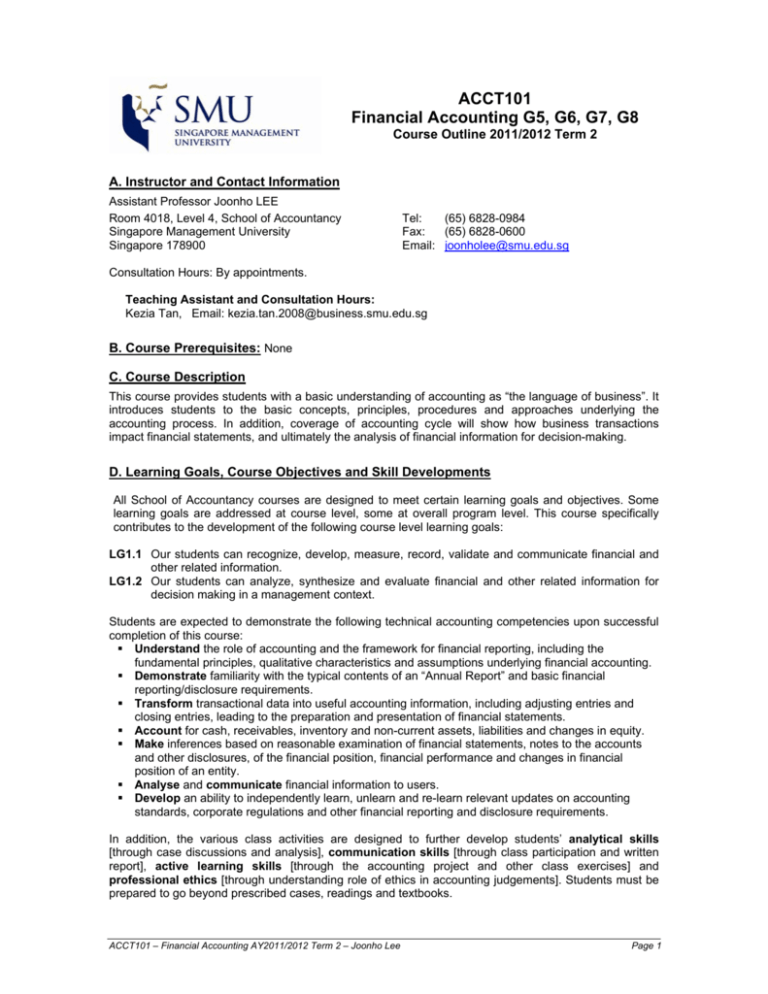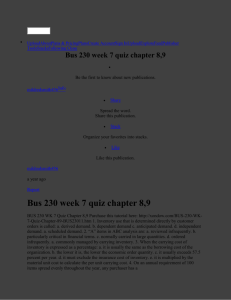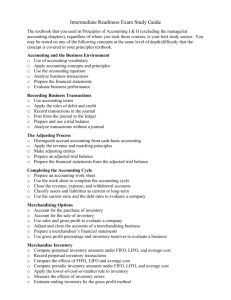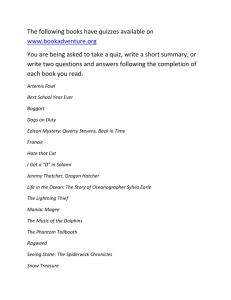
ACCT101
Financial Accounting G5, G6, G7, G8
Course Outline 2011/2012 Term 2
A. Instructor and Contact Information
Assistant Professor Joonho LEE
Room 4018, Level 4, School of Accountancy
Singapore Management University
Singapore 178900
Tel:
(65) 6828-0984
Fax:
(65) 6828-0600
Email: joonholee@smu.edu.sg
Consultation Hours: By appointments.
Teaching Assistant and Consultation Hours:
Kezia Tan, Email: kezia.tan.2008@business.smu.edu.sg
B. Course Prerequisites: None
C. Course Description
This course provides students with a basic understanding of accounting as “the language of business”. It
introduces students to the basic concepts, principles, procedures and approaches underlying the
accounting process. In addition, coverage of accounting cycle will show how business transactions
impact financial statements, and ultimately the analysis of financial information for decision-making.
D. Learning Goals, Course Objectives and Skill Developments
All School of Accountancy courses are designed to meet certain learning goals and objectives. Some
learning goals are addressed at course level, some at overall program level. This course specifically
contributes to the development of the following course level learning goals:
LG1.1 Our students can recognize, develop, measure, record, validate and communicate financial and
other related information.
LG1.2 Our students can analyze, synthesize and evaluate financial and other related information for
decision making in a management context.
Students are expected to demonstrate the following technical accounting competencies upon successful
completion of this course:
Understand the role of accounting and the framework for financial reporting, including the
fundamental principles, qualitative characteristics and assumptions underlying financial accounting.
Demonstrate familiarity with the typical contents of an “Annual Report” and basic financial
reporting/disclosure requirements.
Transform transactional data into useful accounting information, including adjusting entries and
closing entries, leading to the preparation and presentation of financial statements.
Account for cash, receivables, inventory and non-current assets, liabilities and changes in equity.
Make inferences based on reasonable examination of financial statements, notes to the accounts
and other disclosures, of the financial position, financial performance and changes in financial
position of an entity.
Analyse and communicate financial information to users.
Develop an ability to independently learn, unlearn and re-learn relevant updates on accounting
standards, corporate regulations and other financial reporting and disclosure requirements.
In addition, the various class activities are designed to further develop students’ analytical skills
[through case discussions and analysis], communication skills [through class participation and written
report], active learning skills [through the accounting project and other class exercises] and
professional ethics [through understanding role of ethics in accounting judgements]. Students must be
prepared to go beyond prescribed cases, readings and textbooks.
ACCT101 – Financial Accounting AY2011/2012 Term 2 – Joonho Lee
Page 1
E. Learning Approach
The pedagogical approach to this course consists of three interlocking elements:
Instructor-facilitated Learning: Facilitation, Clarification, Synthesis
Individual Learning: Preparation, Analysis, Action
Collaborative Learning: Teamwork, Discussion, Sharing
Learning activities are planned to take into account these three elements of learning. Both the technical
learning and skills objectives will be developed through a blend of theory and practice. An
understanding of basic accounting knowledge on major elements of financial statements is a prerequisite
for any future studies of accounting. Thus, each topic will start with a session on basic technical
knowledge, followed by a practical session, using exercises, discussions, case analysis, and other class
materials to enforce students’ understanding of the topic.
Theories are what you learn in textbooks, the methodological, structured and systematic study of a
discipline. The Harrison and Horngren textbook helps you learn, understand and practice concepts
and theories in financial accounting. You also have access to various e-learning materials (“Financial
Accounting Learning Objects”, FALO for short) in your learning management system (called “e-learn”
at https://elearn.smu.edu.sg/).
Cases are examples that we bring in to class to introduce the relevance of theories and concepts in
actual accounting practices. The casebook (see below) is a collection of case materials (typically
extracts of various annual reports and other readings) to help us appreciate the real-world
importance of the theories and concepts you read. It also highlights that textbook only covers so little
you really need to know about the world.
The role of the instructor is to facilitate, provide clarification of critical concepts, not to read out pages
of the textbook to you. Often, it is important to be able to see the “trees from the forests” and synthesise
on why certain things matters are just as important as how specific processes/procedures are performed.
Students are reminded that their individual contribution to learning starts before class. Students should
prepare by pre-reading, analysing the materials/tasks/cases to be covered before coming to class and
actively participate in class discussions. Preparation is the prerequisite for analysis which will allow you
to take action in your individual learning.
Collaborative learning elements are developed through your contribution to your classmates learning
experiences, either through teamwork in tackling your project or other assigned tasks, and being willing
to contribute to class discussions and share your findings and work so others will benefit. Naturally,
your individual preparation, analysis and action will determine how much you are able to contribute to
collaborative learning.
F. Textbook and Other Resources
Primary Text: Harrison, Horngren, Thomas and
Suwardy (2011), Financial Accounting: International
Financial Reporting Standards, 8th edition, Pearson
Case Book: Suwardy (2010), Understanding Financial
Statements: A Case-Based Approach, Pearson
Prentice-Hall
Additional references: numerous e-learning resources
is available in e-learn
• There are numerous basic financial accounting books in the library that you can further consult for
additional references.
• You may require access to www.asc.gov.sg for selected insights into applicable accounting standards.
In addition, a good summary of accounting standards (“IFRS in Your Pocket 2011”) is available from
IASPLUS http://www.iasplus.com/dttpubs/pocket2011.pdf Whilst you will not be expected to know all
accounting standards in any great detail in your first financial accounting course, you should have an
appreciation of the relevant accounting standards covered in this course. A technical summary of
accounting standards covered in this course will be made available in e-learn.
• Due to the nature of the coverage on emerging issues, students will be expected to read widely from
ACCT101 – Financial Accounting AY2011/2012 Term 2 – Joonho Lee
Page 2
professional, business publications and newspapers.
G. Lesson Plan
Class sessions are of 3-hour duration and will include a review of study materials, class discussions
and other learning activities. Course materials will be published in “e-learn” at
https://elearn.smu.edu.sg/).
A brief outline of course schedule is provided below. A detailed course work plan is available in Annex 1.
Financial Statements and Annual Reports
Recording Business Transactions
Processing Accounting Information
Completing Accounting Cycle
Financial Statement Analysis
Merchandising Operations and Inventory
Cash and Receivables
Property, Plant and Equipment and Intangibles
Liabilities
Owners’ Equity and Income Statement
Cash Flow Statement
H. Assessment and Evaluation
To pass the course, students are required to obtain a TOTAL mark of 50% or better. The assessment
components and grading schemes are listed below:
Components
1. Class Activities:
1-1) Homework (5%)
1-2) Participation (5%)
2. Progress Assessment
2-1) Quiz (12.5%)
2-2) Midterm Exam (12.5%)
3. Assignments
3-1) Group Project Report (10%)
3-2) Group Case Presentation (5%)
4. Final Exam
Sum
Weight
10%
25%
15%
50%
100%
A+
A
AB+
B
BC+
C
CD+
D
F
>=86 %
83-85%
80-82%
77-79%
74-76%
70-73%
66-69%
63-65%
60-62%
53-59%
50-52%
<=49%
1. Class Activities
Homework (5%): Relatively easy homework questions are assigned. The purpose of the
homework problem solving is to motivate your self-study before the class. You are expected to
study class materials before the class and try to solve these homework problems for yourself. To
answer all the questions correctly will be challenging sometimes. Therefore, grading homework is
based on your efforts, not on correctness. When reasonable amount of efforts are thought to be
exerted, two points will be given. One point will be given to the homework which shows obviously
minimal efforts (jotting down several lines). Zero point for no submission.
(There are suggested problems in each class as well. Solving both homework problems and the
suggested problems is essential for the students to perform well in the examinations and the quizzes.
Answer keys for both homework and suggested problems will be ready on e-learn after the
collection of homework).
Participation (5%) and Class Behavior: Maintain proper discipline and conduct yourself in a
responsible manner. Students are encouraged to raise questions and to participate in the class (e.g.,
suggestions, comments, etc). A part of the course grade would be allocated to class participation and
discipline. You will get participation points by providing constructive feedbacks. There are several
specific behavioral codes for this class: 1) NO CELLPHONE, 2) Prudent use of notebook computer
(you may use notebook computer only for class related purpose), 3) Obtain permission from the
professor for absence of the class in advance.
ACCT101 – Financial Accounting AY2011/2012 Term 2 – Joonho Lee
Page 3
2. Progress Assessment
Quizzes (12.5%) and Mid-term Exam (12.5%): Regular quizzes will be given in class. There will be
a total of 5 quizzes. Each quiz has 10 maximum points, and the mid-term exam has 50 maximum
points.
3. Assignments
Group Case Presentation (5%): Students will be assigned into groups (of 4-5 members) randomly
and asked to solve case questions (one case for each group). It is required for each group to present
the case study in class. It is important to participate in the group works equally. To encourage class
participation, not only the presentation group members but also all the students in the class are
required to prepare his/her own answers to the case questions.
Group project (10%): There is a term group project report.
information.
Please see Annex 2 for more
4. Final exam (50%): The final examination is a closed-book, of 3 (three) hours duration and covers the
entire course, scheduled on Monday, 23 April 2012 at 8:30AM.
Requests by students to take the final exam on other than the officially scheduled date/time will not
be approved except under extremely extenuating circumstances entirely beyond the student’s
control. Students who believe they may be unable to take the final exam on the scheduled date and
time should not enrol for this course this term.
I. Additional Comments
1. Make sure you are familiar with e-learn where our course homepage parks, and check the course
homepage regularly in order not to miss important announcements. Major announcements may be
made only through e-learn and it is the sole responsibility of the students to find out what has been
announced during their absence from class.
2. I strongly encourage you to let me know any problems related to this course as soon as they arise.
Please do not allow problems to accumulate because it will be more difficult to solve them later. In
this course, each chapter builds on the previous chapters. It is like constructing a building – the
foundation first, then the ground floor, then the first floor and so on. If you have problems in the
earlier parts, you will not be able to understand the later parts. Moreover, the level of difficulty
increases as lectures progress. It is very easy to get high marks in the earlier quizzes, but it would
be difficult to get even a decent grade in the final exam.
Academic Integrity
All acts of academic dishonesty (including, but not limited to, plagiarism, cheating, fabrication, facilitation
of acts of academic dishonesty by others, unauthorized possession of exam questions, or tampering
with the academic work of other students) are serious offences. All work (whether oral or written)
submitted for purposes of assessment must be the student’s own work. Penalties for violation of the
policy range from zero marks for the component assessment to expulsion, depending on the nature of
the offense. When in doubt, students should consult the instructors of the course. Details on the SMU
Code of Academic Integrity may be accessed at http://www.smuscd.org/resources.html.
Prepared by Joonho LEE, 19 Dec 2011
Approved by Themin SUWARDY, 27 Dec 2011
ACCT101 – Financial Accounting AY2011/2012 Term 2 – Joonho Lee
Page 4
Annex 1: Detailed Course Work Plan
(ACCT101: 2011/2012 Term2 – G5,G6,G7,G8)
Week
Homework
Assignments
(to be submitted)
Topic
Suggested
Problems
(for your own
practice)
E1-17A, 18, 24, 25,
26A,
P1-58A, 59A, 61A
1
Introduction/ Financial Statements and
Annual Reports [HHTS Ch.1], FRS
Framework, CASE1
Key Concepts: Accounting Framework,
Financial Statements, Annual Reports
S2-3, 5, 7, 9,12
2
Recording Business Transactions
[HHTS Ch.2], CASE2
Key Concepts: Analysing Business
Transactions, Accounts, Debits and Credits,
Recording Transaction, Trial Balance
Processing Accounting Information
[HHTS Ch.3], FRS18
Key Concepts: Accrual Accounting, Revenue
and Expense Recognition, Adjusting Entries
S3-1, 3, 10, 11
E2-15A, 20A, 21A,
P2-61A, 62A, 64A
3
Quiz 1
Completing the Accounting Cycle [HHTS
Ch.3], FRS1, CASE3
Key Concepts: Closing Entries, Worksheet,
Presentations of Financial Statements
S6- 4, 5, 7
E3-20A, 28A, 31A,
33A,
P3-70A, 71A, 75A,
76A
4
Inventory and COGS [HHTS Ch.6], FRS2
,CASE4
Key Concepts: Accounting for Inventory,
Inventory Cost Flows, Inventory Valuation,
Inventory Errors
Group 1 Case Presentation (Case4- Q1,2,3,4)
S6-11,12 ,
S6A-1,2
S4- 8, 9
E6-17A, 19A, 27A
5
Quiz 2
Inventory and COGS- continue
[HHTS Ch.6] (including Appendix 6A)
Cash [HHTS Ch.4 (exclude internal control)]
CASE11
Key Concepts: Bank Reconciliation
Group 2 Case Presentation (Case11-Q1,2,3,4)
S5- 6
P6-61A, 64A,
E6A-5B, 6B,
P6A-7A,
E4-21A, P4-55A
6
Receivables [HHTS Ch.5] (exclude shortterm investments), CASE10
Key Concepts: Receivables and Accounting for
Bad Debts
Group 3 Case Presentation (Case10-Q1,2,3,4,5)
S7-4, 5, 6
E5-20A,
P5-57A
7
Quiz 3
PPE and Intangible Assets [HHTS Ch.7,
FRS16,36,38] CASE12
Key Concepts: Long Term Assets, Asset
Purchases, Capital Expenditure vs Revenue
Expenditure, Depreciation, Disposals of Assets,
Intangible Assets
Group 4 Case Presentation (Case12Q1,2,3,4,5,6)
S8- 1, 2
E7-15A, 22A,
P7-62A, 64A, 67A
Recession Week, No Class
ACCT101 – Financial Accounting AY2011/2012 Term 2 – Joonho Lee
Page 5
9
Midterm
Exam
Liability [HHTS Ch.8 and Appendix B],
FRS17,37
Key Concepts: Current Liabilities, Time Value of
Money, Non-Current Liabilities (Bonds, Leases),
Contingent Liabilities
S8- 6, 7, 8
E8-21A,
10
Liability – continue [HHTS Ch.8 and
Appendix B] FRS17,37, CASE13
Key Concepts: Current Liabilities, Time Value of
Money, Non-Current Liabilities (Bonds, Leases),
Contingent Liabilities
Group 5 Case Presentation
(Case13-Q1,2,3,4,6)
S9- 5, 6, 10
S11- 3, 4
E8-24A, 25A,
P8-73A, P8-76A
11
Quiz 4
Shareholder Equity and Income Statement
[HHTS Ch.9 & 11], FRS1, CASE16
Key Concepts: Share Issuance, Repurchase,
Capital Reduction and Treasury Shares,
Dividends, Presentation of Income Statement
Group 6 Case Presentation (Case16-Q1,2,3,4,5)
S12- 5, 6, 11
E9-24A,
P9-76A, 77A, 78A,
E11-17A, P11-45A
12
Statement of Cash Flows [HHTS Ch.12],
FRS7, CASE17
Key Concepts: Preparing Statement of Cash
Flow, Operating Activities, Investing Activities,
Financing Activities, Direct/Indirect Method
Group 7 Case Presentation (Case17-Q1,2,3,4)
S13- 6, 7, 8
E12-20A, 22A, 26A,
P12-60A, 61A
13
Quiz 5
Financial Statement Analysis [HHTS Ch.13],
FRS14,108, CASE18
Key Concepts: Horizontal, Vertical and Trend
Analysis, Financial Ratios, Limitations, Segment
Reporting
Group 8 Case Presentation (Case18-Q1,2,3,4)
N.A
E13-18A, 21A,
P13- 52A, 53A,55A
14
Self-review of the course and preparation for the N.A.
final exam, No class
Final Exam
Monday, 23 April 2012, 8:30AM
Venues will be announced later.
ACCT101 – Financial Accounting AY2011/2012 Term 2 – Joonho Lee
N.A.
Page 6
Annex 2: Guideline for Term Group Project
Aim
The group project aims to provide you with an understanding of the annual reports. You should be able
to critically analyze and evaluate various aspects of the financial statements, with emphasis on (but not
limited to) the topics discussed in the course.
Your group will assume the role of a financial analyst and conduct research for a client (e.g., an individual
investor). Alternatively you could assume the role of a product manager evaluating competitors. Your
client has asked you to analyze the financial statements of one company and its two competitors – you
may choose its two major competitors from the same industry. Your analysis should focus on the chosen
company. However, you need to compare its performance with those of other two companies in the same
industry.
Assessment and Submission
The group project report carries 10% of the total marks of the course. It will be graded on content and
level of analysis. Students are expected to work in a group and members of a group would peerevaluate the contribution of group members. The due time for submission of the project report is 5pm on
April 12th 2012 (Thursday). Late submission will not be accepted.
Company Selection
Each group must select a company from the list which will be provided later.
Format
•
•
Ten pages maximum – Your report should include supporting analyses as appendices to the
ten pages. Soft copy of the latest available Annual Report used in the analysis must be emailed
to me. Your data should cover at least two years of latest annual reports.
Typed, 1.5 line spaced, 12 point font size.
Content
The final report must include 1) a cover page, 2) executive summary, 3) analyses, and 4) conclusions.
You are required to address all questions with (*) listed below. Feel free to address other listed questions
in your report. Workings, if any, must be shown. You may use other sources of information (e.g.
company’s website, press release, newspaper clippings, etc) but they must be properly sourced and
noted. Your report should not be just a “bullet point” list of answers. It must show a coherent flow and
exhibit a cohesive examination of the company. You must discuss the subject firms’ profitability
(including quality and persistence of earnings), effectiveness of asset utilization, debt servicing (liquidity,
risk assessment), cash flows management, and overall performance where they are applicable.
Company and Industry Overview
(*)What are the principal activities of the company?
What is the geographical coverage of the company?
(*)What are the major trends in the industry?
(*)Who are the companies’ major competitors?
Have any significant events happened at your companies that will be important to consider as you
analyze their results?
Income Statement Discussions
(*)What were the company’s total revenues for the year under review?
State the composition of the revenues of the company, allocate according to products, locations,
activities, etc where possible.
(*)What are the bases of revenue recognition adopted by the company? Are they appropriate?
(*)Looking at the revenue and net income in the three years presented in the annual report, would
you say the company has had a good year? Provide evidence to justify your conclusion.
(*)Draw up a common-sized statement for the year under review. Comment on the result.
Current Assets and Current Liabilities
(*)If your company has inventory, state which inventory cost flow assumption is used.
(*)What is the working capital of the company for the year under review and that of the previous
year?
State the composition of current assets and current liabilities for each year.
ACCT101 – Financial Accounting AY2011/2012 Term 2 – Joonho Lee
Page 7
(*)If your company has allowance for doubtful accounts, show how this allowance is determined.
Long-Term Assets
List by types and amounts the property, plant and equipment of the company.
(*)What depreciation method does the company use for financial reporting? Is it appropriate?
Long Term Debt and Equity Financing
State the nature and amount of each liability in the long-term liabilities section of the balance sheet.
(*)Considering your company’s operating circumstances, which do you think is the best way to
finance its purchase of long-term assets; through internally generated funds, shareholders’
contributions, or through long-term borrowings?
Statement of Cash Flows
(*)Compare the company’s cash position for the year under review with that of the previous year.
Comment on the improvement or deterioration of the company’s cash position.
(*) Which method (direct or indirect) did the company use in the preparation of its statement of cash
flows?
(*)State the main sources of cash inflow during the year and the main uses to which cash has been
used.
Financial Statements Analyses
(*)Compute major financial ratios.
(*)Calculate and comment on the efficiency ratios.
(*)Calculate and comment on the profitability ratios.
(*)Calculate and comment on the investment ratios.
Useful references
1.
2.
3.
4.
5.
6.
7.
8.
9.
10.
Accounting Standards Council (ASC) : http://www.asc.gov.sg/
Singapore Exchange (SGX): http://www.sgx.com/ (annual reports are available)
U.S. Securities and Exchange Commission (SEC): http://www.sec.gov/
U.S. Financial Accounting Standards Board (FASB): http://www.fasb.org/
New York Stock Exchange (NYSE): http://www.nyse.com/
NASDAQ: http://www.nasdaq.com/
MSN Money: http://moneycentral.msn.com/investor/sec/filing.asp?Symbol
Yahoo Finance: http://finance.yahoo.com/
WSJ Free Annual Reports: http://wsjie.ar.wilink.com/asp/WSJ3_search_eng.asp
Thomson ONE Banker and OneSource: Databases from SMU Library website
ACCT101 – Financial Accounting AY2011/2012 Term 2 – Joonho Lee
Page 8







